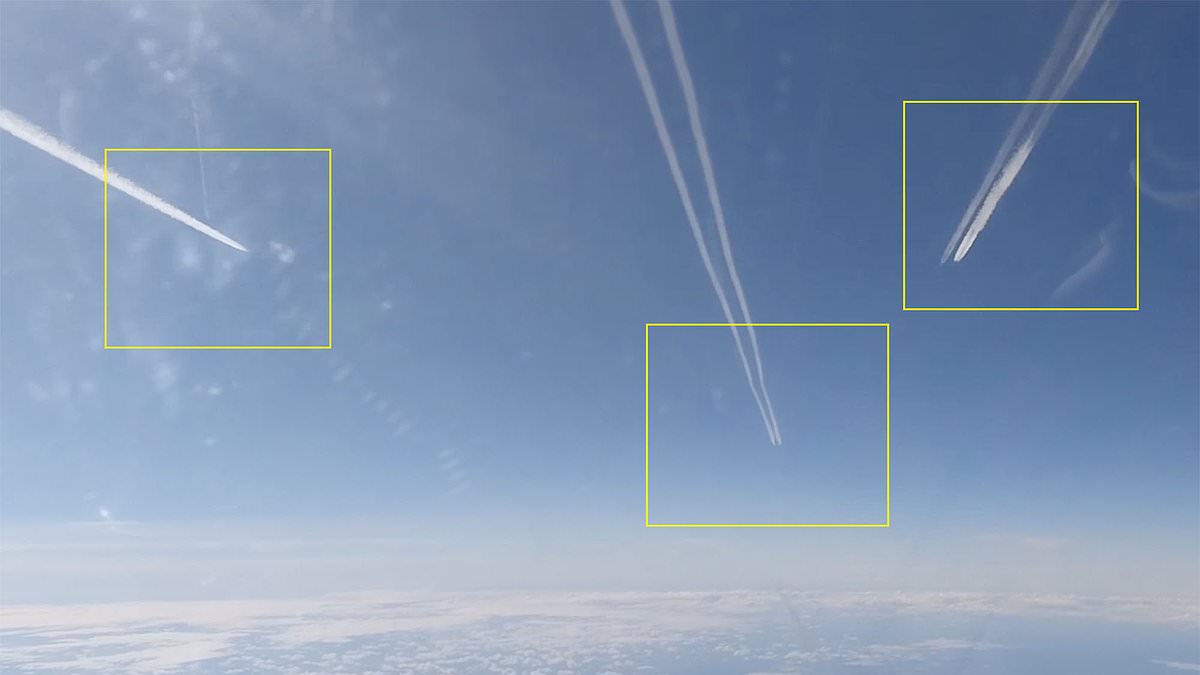This is the moment Russian SU-27 fighter jets buzzed an RAF spy plane and Typhoons over the Black Sea.
Two Russian Su-27 fighter jets were scrambled in response to the approach by the RC-135 ‘electronic warfare aircraft’ and its escorts, Moscow said.
‘A pair of Su-27 fighters from the air defence duty force were flown to identify the air targets and prevent violation of the state border of the Russian Federation,’ the country’s defence ministry said.
‘The Russian fighter crews identified the aerial targets as an RC-135 radio-technical reconnaissance and electronic warfare aircraft and two British Air Force Typhoon multirole fighters.’
Footage taken from an aircraft’s cockpit shows the planes leaving trails across the sky.
Footage taken from an aircraft’s cockpit shows the planes leaving trails across the sky.
Two Russian Su-27 fighter jets were scrambled in response to the approach by the RC-135 ‘electronic warfare aircraft’ and its escorts, said Moscow
The ministry claimed: ‘As the Russian fighters approached, the foreign military aircraft performed a U-turn away from the state border of the Russian Federation.’
The Russian’s alleged interception ‘was carried out in strict compliance with international rules on the use of airspace over neutral waters, without crossing air routes or coming dangerously close to aircraft of a foreign state’.
News agency TASS boasted that the Russian Su-27s acted to ‘prevent British planes from violating the state border over the Black Sea’.
Yet the statement admitted that the RAF planes were ‘in airspace over neutral waters’.
The footage was filmed on Thursday but released today by Vladimir Putin’s defence ministry.
NATO is known to closely monitor Russia’s hostile actions against Ukraine, much of it carried on from occupied areas of Ukraine like Crimea.
The incident came amid high tension over Putin’s war in Ukraine, with the Kremlin furious over the U.S. supply of new long range ATACMS weapons to Kyiv.
Video showed one of the planes up close. ‘The Russian fighter crews identified the aerial targets as an RC-135 radio-technical reconnaissance and electronic warfare aircraft and two British Air Force Typhoon multirole fighters,’ Russia’s defence ministry said
A view from the cockpit of the planes. ‘A pair of Su-27 fighters from the air defence duty force were flown to identify the air targets and prevent violation of the state border of the Russian Federation,’ the country’s defence ministry said
Putin visited the headquarters of Russia’s Southern Military District late on Thursday, which is located less than 100 kilometers (60 miles) from Ukraine’s southeastern border.
He was briefed on the war by the chief of the General Staff, Valery Gerasimov, the Kremlin said.
With the scale of the Western aid that Kyiv can expect going forward uncertain, and after a five-month-long Ukrainian counteroffensive that drained Russia’s reserves but apparently only dented its front-line defenses, both countries are scrambling to replenish their stockpiles for 2024.
US President Joe Biden urgently requested military aid on Friday for Ukraine and Israel in a massive $106 billion national security package, but Republican paralysis in Congress means it hit an immediate wall.
Ukraine has been expending ammunition at a rate of more than 200,000 rounds per month, according to Jack Watling, a senior research fellow at the Royal United Services Institute think tank in London.
Russia’s President Vladimir Putin, accompanied by Army chief of staff Valery Gerasimov, visits the military headquarters in Rostov-on-Don that is overseeing the country’s military action in Ukraine, on October 19, 2023
Putin and Russian Chief of General Staff Gen. Valery Gerasimov talk to each other as they walk down the stairs at the headquarters of Russia’s Southern Military District in Rostov-on-Don, Russia, on Oct. 19, 2023
‘Sufficient ammunition to sustain this rate of fire is not going to be forthcoming as NATO stockpiles deplete, and production rates for ammunition remain too low to meet this level of demand,’ Watling wrote in an assessment published late on Thursday.
Meanwhile, Russian production ‘has turned a corner,’ he said.
Moscow’s domestic ammunition production is growing quickly, at more than 100 long-range missiles a month compared with 40 a month a year ago, for example, according to Watling.
Also, Russia is reported to be receiving supplies from Iran, North Korea and other countries.
Though the counteroffensive has not made dramatic progress against Russia’s formidable defenses, it has suppressed gains by the Kremlin’s forces.
If Ukraine can keep up the pressure, it would further stretch Russia’s already strained manpower resources, according to the Institute for the Study of War.
